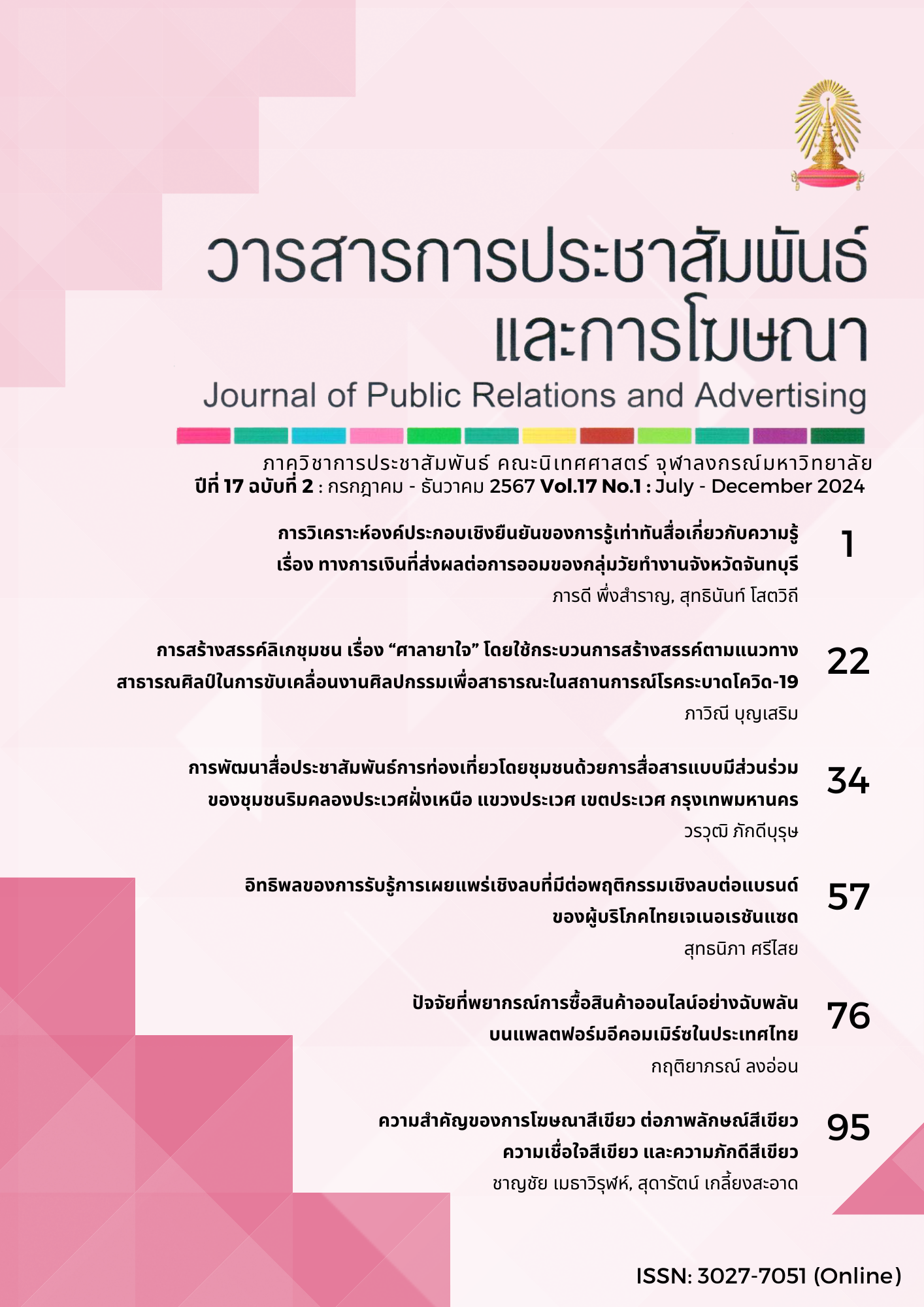การพัฒนาสื่อประชาสัมพันธ์การท่องเที่ยวโดยชุมชนด้วยการสื่อสารแบบมีส่วนร่วมของชุมชนริมคลองประเวศฝั่งเหนือ แขวงประเวศ เขตประเวศ กรุงเทพมหานคร
Main Article Content
บทคัดย่อ
การวิจัยผสมวิธีนี้มีวัตถุประสงค์เพื่อ 1) ศึกษาบริบทชุมชน การจัดการท่องเที่ยวโดยชุมชน และความต้องการสื่อประชาสัมพันธ์การท่องเที่ยวโดยชุมชนของชุมชนริมคลองประเวศฝั่งเหนือ แขวงประเวศ เขตประเวศ กรุงเทพมหานคร 2) วิเคราะห์ศักยภาพด้านการท่องเที่ยวโดยชุมชนของชุมชนริมคลองประเวศฝั่งเหนือ แขวงประเวศ เขตประเวศ กรุงเทพมหานคร 3) พัฒนาสื่อประชาสัมพันธ์การท่องเที่ยวโดยชุมชนของชุมชนริมคลองประเวศฝั่งเหนือ แขวงประเวศ เขตประเวศ กรุงเทพมหานคร และ 4) ประเมินผลของสื่อประชาสัมพันธ์การท่องเที่ยวโดยชุมชนของชุมชนริมคลองประเวศฝั่งเหนือ แขวงประเวศ เขตประเวศ กรุงเทพมหานคร ที่มีต่อนักท่องเที่ยว ผู้เข้าร่วมการวิจัยเชิงคุณภาพ มีจำนวน 25 คน วิเคราะห์ข้อมูลด้วยวิธีการเชิงคุณภาพเพื่อหาข้อสรุปแบบอุปนัย และกลุ่มตัวอย่างในการวิจัยเชิงปริมาณ คือ นักท่องเที่ยว จำนวน 400 คน ซึ่งได้จากการเลือกแบบเจาะจง วิเคราะห์ข้อมูลด้วยสถิติเชิงพรรณนาและการหาค่าสัมประสิทธิ์สหสัมพันธ์แบบเพียร์สัน ผลการวิจัยพบว่า 1) ชุมชนริมคลองประเวศฝั่งเหนือเป็น “ชุมชนพหุวัฒนธรรม” ที่ผสมผสานกันระหว่างวัฒนธรรมอิสลามและวัฒนธรรมพุทธ มีสภาพแวดล้อมส่วนใหญ่เป็นพื้นที่ สีเขียว มีทรัพยากรการท่องเที่ยวที่สำคัญ ได้แก่ (1.1) มัสยิดยามิอุ้ลอิบาดะห์ (1.2) สะพานไม้เก่าอายุกว่า 100 ปี (1.3) คลองประเวศบุรีรมย์ (1.4) ชมรมบ้านเจียระไนพลอย (1.5) บ้านผ้าปักสุนิสา และ (1.6) ฟาร์มเลี้ยงแพะ “แบมะฟาร์ม” การจัดการท่องเที่ยวโดยชุมชนของชุมชนริมคลองประเวศฝั่งเหนือ สอดคล้องตามองค์ประกอบหลักของการท่องเที่ยวโดยชุมชน 4 ประการ ได้แก่ ทรัพยากรการท่องเที่ยว องค์กรชุมชน การจัดการ และการเรียนรู้ ชุมชนมีความต้องการสื่อประชาสัมพันธ์การท่องเที่ยวโดยชุมชนที่ทันสมัย มีข้อมูลที่เป็นปัจจุบัน ช่วยสร้างการรับรู้ และตรงกับความต้องการของนักท่องเที่ยว 2) ศักยภาพด้านการท่องเที่ยวโดยชุมชนของชุมชนริมคลองประเวศฝั่งเหนือ ประกอบด้วย (2.1) ด้านทรัพยากรการท่องเที่ยว (2.2) ด้านการเข้าถึงชุมชน (2.3) ด้านสิ่งอำนวยความสะดวก (2.4) ด้านการรองรับนักท่องเที่ยว และ (2.5) ด้านการจัดการท่องเที่ยว 3) การพัฒนาสื่อประชาสัมพันธ์การท่องเที่ยวโดยชุมชนของชุมชนริมคลองประเวศฝั่งเหนือ ด้วยการสื่อสารแบบมีส่วนร่วมของชุมชนในฐานะผู้ถ่ายทอดข้อมูลข่าวสารและผู้ร่วมผลิตสื่อ ประกอบด้วยสื่อประชาสัมพันธ์การท่องเที่ยวโดยชุมชน
6 สื่อ ได้แก่ (3.1) วีดิทัศน์สารคดีท่องเที่ยว (3.2) คู่มือท่องเที่ยว (3.3) แผ่นพับ (3.4) โปสเตอร์ (3.5) เฟซบุ๊ก และ (3.6) อินโฟกราฟิก ทั้งนี้ผลการประเมินคุณภาพสื่อจากผู้เชี่ยวชาญและคนในชุมชนทั้งหมดจำนวน 15 ท่าน พบว่า โดยภาพรวมอยู่ในระดับมาก และ 4) ผลของสื่อประชาสัมพันธ์การท่องเที่ยวโดยชุมชนของชุมชนริมคลองประเวศฝั่งเหนือมีต่อนักท่องเที่ยวด้านการใช้ประโยชน์และความพึงพอใจในระดับมาก การเปิดรับสื่อประชาสัมพันธ์การท่องเที่ยวของนักท่องเที่ยวมีความสัมพันธ์ทางบวกกับการใช้ประโยชน์และความพึงพอใจในระดับมาก อย่างมีนัยสำคัญทางสถิติที่ระดับ .01
Article Details
เอกสารอ้างอิง
กนกกานต์ แก้วนุช. (2564). การจัดการการท่องเที่ยวและการพัฒนาชุมชนการท่องเที่ยวภายใต้พลวัตโลก. กรุงเทพฯ: ฟรีมายด์ พับลิชชิ่ง.
กฤษณ์ จุฑามณี. (2564). การจัดการการท่องเที่ยวอย่างยั่งยืนของชุมชนริมคลองประเวศฝั่งเหนือ. กรุงเทพมหานคร. กรุงเทพ ฯ: สถาบันบัณฑิตพัฒนบริหารศาสตร์.
กาญจนา แก้วเทพ และกำจร หลุยยะพงศ์. (2560). การใช้ประโยชน์จากงานวิจัยด้วยเครื่องมือการสื่อสาร: แนวคิดและบทสังเคราะห์. กรุงเทพฯ : หยินหยางการพิมพ์.
กฤษฎา สุริยวงศ์, วันชัย หวนนากลาง และฐิตินัน บุญภาพ คอมมอน. (มกราคม – มิถุนายน 2564). การสื่อสารเพื่อการพัฒนาการท่องเที่ยวเชิงสร้างสรรค์โดยชุมชนมีส่วนร่วมของจังหวัดเพชรบุรี. วารสารมนุษย์สังคมปริทัศน์, 23(1), 43-57.
กัลยา วานิชย์บัญชา. (2561). การวิเคราะห์สถิติขั้นสูงด้วย SPSS for Windows. พิมพ์ครั้งที่ 13 กรุงเทพฯ: จุฬาลงกรณ์มหาวิทยาลัย.
ชัชพล ทรงสุนทรวงศ์. (2565). การจัดการทรัพยากรการท่องเที่ยวและโรงแรมอย่างยั่งยืน. พิมพ์ครั้งที่ 2. กรุงเทพฯ: สำนักพิมพ์แห่งจุฬาลงกรณ์มหาวิทยาลัย.
ชุติกาญจน์ กันทะอู. (2560). การท่องเที่ยวโดยชุมชนเป็นฐาน: กรณีศึกษา บ้านร่องฟอง ตำบลร่องฟอง อำเภอเมืองแพร่ จังหวัดแพร่. วิทยานิพนธ์ปริญญาศิลปศาสตรมหาบัณฑิต สาขาพัฒนามนุษย์และสังคม จุฬาลงกรณ์มหาวิทยาลัย.
รุ่งรวี จิตภักดี. (2566). นวัตกรรมการท่องเที่ยวโดยชุมชน. กรุงเทพฯ : สำนักพิมพ์จุฬาลงกรณ์มหาวิทยาลัย.
ศิริประภา ประภากรเกียรติ. (2563). การพัฒนาสื่อประชาสัมพันธ์การท่องเที่ยวโดยใช้แนวคิดชุมชนเป็นฐาน. มหาสารคาม: มหาวิทยาลัยมหาสารคาม.
สถาบันการท่องเที่ยวโดยชุมชน. (2566). รู้จักการท่องเที่ยวโดยชุมชน (CBT). วันที่เข้าถึงข้อมูล 1 กุมภาพันธ์ 2566 แหล่งที่มา https://cbtyouth.wordpress.com/cbt-youth/cbt.
สมาน โตหัวป่า. (2566), สัมภาษณ์โดยวรวุฒิ ภักดีบุรุษ.
สลิตตา สาริบุตร และณัฐพงษ์ สีบุญเรือง. (2563) “การพัฒนารูปแบบสื่อประชาสัมพันธ์เพื่อส่งเสริมการท่องเที่ยวเชิงนิเวศน์ อย่างยั่งยืน: ศึกษากรณี ชุมชนชาวมอญจังหวัดปทุมธานี”. วารสารวิชาการการตลาดและการจัดการ โครงการปริญญาโท คณะบริหารธุรกิจ, 7(2), 15-25.
สำนักงานเขตประเวศ. (2565). ข้อมูลประชากรเขตประเวศ กรุงเทพมหานคร. กรุงเทพฯ : สำนักงานเขตประเวศ.
สมาน โตหัวป่า. (สัมภาษณ์), 7 เมษายน 2566.
องค์การบริหารการพัฒนาพื้นที่พิเศษเพื่อการท่องเที่ยวอย่างยั่งยืน (องค์การมหาชน). (2561). แผนพัฒนาการท่องเที่ยวแห่งชาติ ฉบับที่ 3 (พ.ศ. 2566 - 2570). กรุงเทพฯ: องค์การบริหารการพัฒนาพื้นที่พิเศษเพื่อการท่องเที่ยวอย่างยั่งยืน.
อภิสรา กฤตาวาณิชย์. (2564). การพัฒนาสื่อประชาสัมพันธ์ดิจิทัลเพื่อส่งเสริมการท่องเที่ยวตามศาสตร์พระราชาของศูนย์เรียนรู้ศาสตร์พระราชา อำเภอเชียงแสน จังหวัดเชียงราย. วารสารนิเทศศาสตรปริทัศน์, 25(2), 140-152.
อุษา บิ้กกิ้นส์. (2566). รณรงค์การตลาดเพื่อสังคมระดับชุมชน. กรุงเทพฯ : สถาบันบัณฑิตพัฒนบริหารศาสตร์.
Bajracharya, S. (2022). Uses and Gratifications Theory. Retrieved March 7, 2022 from https://www.business topia.net/mass-communication/uses-gratifications-theory.
Communication Studies. (2022). Uses and Gratifications Theory. Retrieved March 1, 2022 from http://www. communicationstudies.com/communication-theories/uses-and-gratifications-theory
Dominick, J. R. (2013). The dynamics of mass communication: Media in transition. (12th ed.). New York: McGraw-Hill.
Littlejohn, S. W., Foss, K. A., & Oetzel, J. G (2017). Theories of Human Communication. (11th ed.). Long Grove IL: Waveland.
Lattimore, D., Baskin, O., Heiman, S., & Toth, E. (2012). Public relations: The profession and the practice. (4th ed.). New York: McGraw-Hill.
Media College. (2023). Media production process. Retrieved May 6, 2023 from https://www.media college.com/glossary/p/production-process.html
Petrovici, A. (2014). “Public Relations in Tourism. A Research on The Perception of The Romanian Public Upon Responsible Tourism”in Procedia - Social and Behavioral Sciences, 163, 67–72.
Lattimore et al. (2013). Public Relations: The Profession and the Practice. (4rd ed.). Boston: McGraw-Hill Higher Education.
Newsom, D., Turk, J., & Kruckeberg, D. (2010). This is PR: The realities of public relations. (10th ed.). Boston, MA: Wadsworth Cengage Learning
Torossian, R. (2023). The role of PR in Tourism and Travel. Retrieved May 6, 2023 from https://ronntorossianupdate.com/the-role-of-pr-in-tourism-and-travel.
Tufte, T., & Mefalopulos, P. (2023). Participatory Communication: A Practical Guide. Retrieved May 6, 2023 from https://documents.worldbank.org/pt/publication/documents-reports/documentdetail/682081468166154717/participatory-communication-a-practical-guide.
Vinney, C. (2022). What Is Uses and Gratifications Theory? Definition and Examples. Retrieved May 1, 2022 from https://www.thoughtco.com/uses-and-gratifications-theory-46283 33.
Wilcox, D. L., Cameron, G. T., & Reber, B. H. (2023). Public Relations: Strategies and Tactics. (12th ed.). Boston: Pearson Education.
Zhang, J., Hamilton, W, L. Danescu-Niculescu-Mizil, C. Jurafsky, D., & Leskovec, J. (2017). Community Identity and User Engagement in a Multi-Community Landscape. Retrieved May 1, 2023 from https://arxiv.org/abs/1705.09665.


